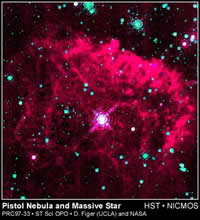The convection zone of the Sun
Click on image for full size
The Convection Zone
The convection zone is farther away from the core than the the radiative zone.
At this point turbulent convective motions occur, similar to a pot of boiling water. The overturning (bubbling) motions inside the Sun are
responsible for the granulation pattern seen on the Sun's surface.
You might also be interested in:

To understand how our Sun works, it helps to imagine that the inside of the Sun is made up of different layers, one inside the other. The core, or the center of the Sun, is the region where the energy
...more
Thermal physics is a field of science that deals with heat and temperature. When we study topics like global warming, the Earth's solid and liquid cores, and the way in which energy flows from the center
...more
What are the "parts" of the Sun? The photosphere is the visible "surface" of the Sun. The three regions of the solar interior are the core, the radiative zone, and the uppermost convective
...more
The Sun's radiative zone is the section of the solar interior between the innermost core and the outer convective zone. In the radiative zone, energy generated by nuclear fusion in the core moves outward
...more
The convection zone is farther away from the core than the the radiative zone. At this point turbulent convective motions occur, similar to a pot of boiling water. The overturning (bubbling) motions inside
...more
IMF stands for Interplanetary Magnetic Field. It is another name for the Sun's magnetic field. The Sun's magnetic field is huge! It goes beyond any of the planets. The Sun's magnetic field got its name
...more
In the basic Hydrogen fusion cycle, four Hydrogen nuclei (protons) come together to make a Helium nucleus. This is the simple version of the story. There are actually electrons, neutrinos and photons involved
...more
Fusion in the core of stars is reached when the density and temperature are high enough. There are different fusion cycles that occur in different phases of the life of a star. These different cycles make
...more











